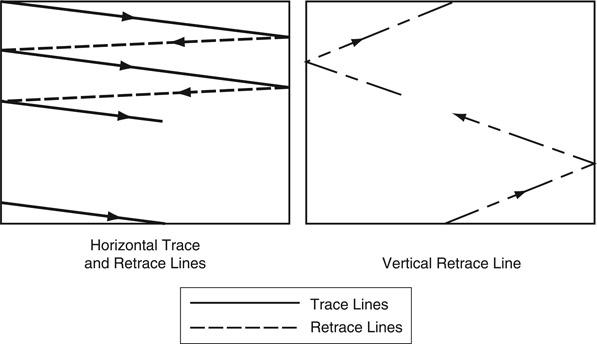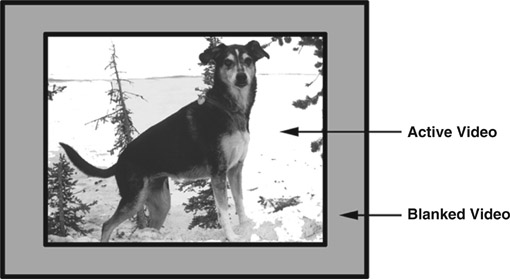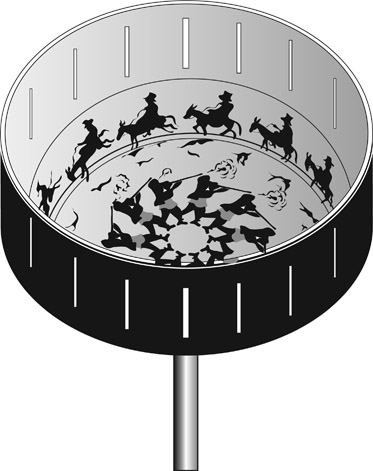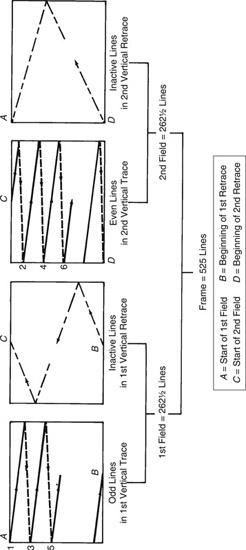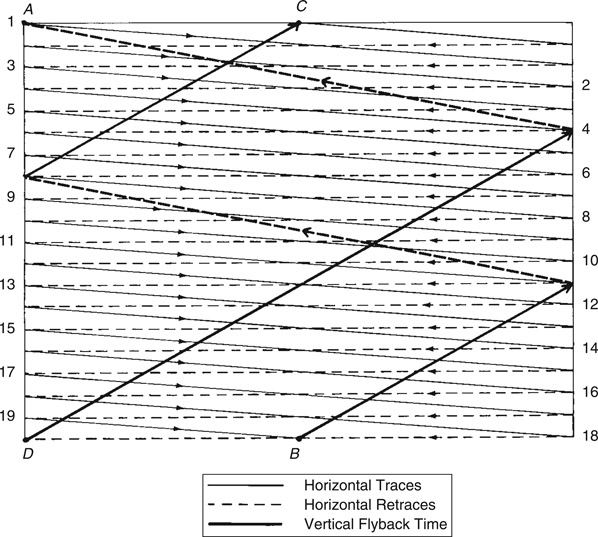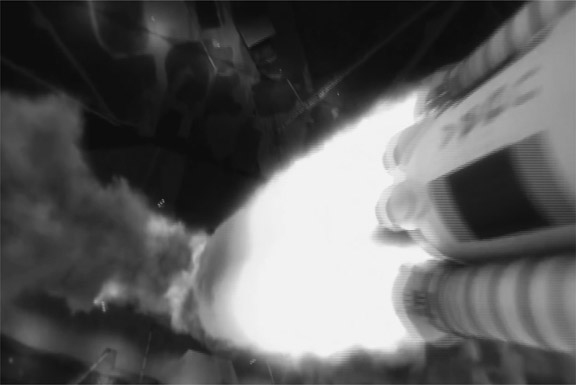When looking at a picture, such as a photograph or a drawing, the human eye takes the scene in all at once. The eye can move from spot to spot to examine details, but in essence, the entire picture is seen at one time. Likewise, when watching a film, the eye sees moving images go by on the screen. The illusion of motion is created by projecting many pictures or frames of film each second. The eye perceives motion, even though the film is made up of thousands of individual still pictures. Video is different from film in that a complete frame of video is broken up into component parts when it is created.
Video Lines
In a tube camera, the electron beam transforms a light image into an electronic signal. Then, an electron beam within a CRT video receiver or monitor causes chemicals called phosphors to glow so they transform the electrical signal back into light.
The specifications for this process were standardized by the National Television System Committee, or NTSC, when the television system was originally conceived in the late 1930s. The NTSC standard was used in North America and parts of Asia and Latin America. As other countries developed their own television systems, other video standards were created. Eastern and Western Europe used a system called PAL (Phase Alternate Line). France and the countries of the former Soviet Union used a system known as SECAM (Séquential Colour Avec Mémoire, or Sequential Color with Memory). Most developed countries have switched to transmission of television using digital standards, making these analog formats obsolete. However, there are still places in the world where analog broadcasts remain.
NOTE The United States switched to digital broadcasting in 2009, but the NTSC standard lives on in many consumer video products. Cable boxes, TV receivers, disk players and games often include an output simply labeled “video.” This is the same signal discussed here.
For each NTSC video frame, the electron beam scanned a total of 525 lines. There were 30 frames scanned each second, which means that a total of 15,750 lines (black and white video) were scanned each second (30 frames x 525 lines per frame). This rate was called the line frequency. Scanning 15,750 lines per second is so fast that the eye never notices the traveling beam. The video image is constantly refreshed as the electron beam scans the 525 lines in each frame. As soon as one frame is completely displayed, scanning begins on the next frame, so the whole process appears seamless to the viewer.
The NTSC line frequency and frame rate changed with the addition of color. Both PAL and SECAM used 625 lines per frame at 25 frames per second. These two systems were developed after the introduction of color television and consequently did not require any additional changes. There are variations and combinations that attempt to combine the best elements of all of these standards.
Blanking
An electron beam scanning a picture tube is like an old typewriter. It works in only one direction. When it reaches the end of a line of video, it must retrace or go back to the other side of the screen to start the next line. Likewise, when it reaches the bottom of the image, it must retrace or go back to the top of the image to begin scanning the next frame (Figure 3.1).
The period of time during which the electron beam retraces to begin scanning or tracing the next line is part of a larger time interval called horizontal blanking. The period of time that the electron gun is retracing to the top of the image to begin scanning another frame is called vertical blanking. During horizontal or vertical blanking, the beam of electrons is blanked out or turned off, so as not to cause any voltage to flow. This way the retrace is not visible.
The horizontal blanking interval is the separation between consecutive lines. The vertical blanking interval is the separation between consecutive frames. As the video image is integrated with other images, using equipment such as video editing systems or video switchers, the change from source to source occurs during the vertical blanking interval after a complete image has been drawn. This can be compared to splicing on the frame line of a film frame.
Horizontal blanking actually occurs slightly before the beginning of each line of video information. Vertical blanking occurs after each frame. The video picture itself is referred to as active video (Figure 3.2). In the NTSC system, active video uses 480 out of the 525 lines contained in one frame. PAL and SECAM use 580 active lines out of the 625 total lines. Blanking functions as the picture frame around the active video. It is a necessary component of the TV signal, even though the electron beam is shut off.
Persistence of Vision
Film is shot at 24 frames per second. However, if it were projected at that rate, a flickering quality to the moving image would be noticeable. The flickering is a result of the phenomenon that lets us perceive motion in a movie in the first place. That phenomenon is called persistence of vision.
Persistence of vision means that the retina, the light-sensitive portion of the human eye, retains the image exposed to it for a certain period of time. This image then fades as the eye waits to receive the next image. The threshold of retention is 1/30 to //32 of a second. If the images change on the retina at a rate slower than that, the eye sees the light and then the dark that follows. If the images change at a faster rate, the eye sees the images as continuous motion and not as individual images. This concept was the basis of a device developed in the 19th century called the Zoetrope (Figure 3.3). By
viewing a series of still images through a small slit in a spinning wheel, the characters in the images appeared to move.
In film, this concept is exploited by simply showing each frame twice. The picture in the gate of the film projector is held, and the shutter opens twice. Then the film moves to the next frame and the shutter again reveals the picture twice. In this way, 48 frames per second are shown while the projector runs at 24 frames per second, and the eye perceives smooth, continuous motion.
Fields
The 30-frames-per-second frame rate of video could potentially allow the flicker of the changing frames to be noticeable. Therefore, the frame rate needed to be increased. The simplest way to do this would be to double the frame rate to 60 frames per second. This was a technological challenge in the early days of tube electronics. The engineers of the time solved the problem by breaking the 30 frames they were able to capture into 60 half frames called fields, each field containing alternating scan lines of the frame.
The pickup camera processing circuits read out every other line of the video frame. Since there are 525 lines that make up a complete frame, or 1/30 of a second, scanning every other line yields 262½ lines scanned per field, or 1/60 of a second (Figure 3.4). Two fields of 262½ lines each combine to make 525 lines, or one complete frame (Figure 3.5). The process was the same in PAL and SECAM, taking into consideration their line and frame rates.
Interlace Scanning
The process of this field-by-field scanning is known as interlace scanning because the lines in each field interlace with the alternate
lines of the other field. There are two fields for each frame. Because the images are appearing at the rate of 1/60 of a second, the eye does not see the interval between the two fields. Therefore, the eye perceives continuous motion.
Try This
An interesting experiment that illustrates the concept of interlace scanning is to have your eyes follow a similar scanning pattern as the electron beam would on a frame of video. Look at the paragraph below and first read just the boldfaced, odd lines. Then go back to the top of the paragraph and read the non-boldfaced, even lines. Notice the way the eyes retrace from the end of a line back to the left margin to begin scanning the next odd line. At the end of the paragraph, the eyes retrace from the last line back to the top again to read or scan the even lines. This is what the electron beam does during its blanking periods.
A television image is created through
Interlace scanning. Interlace scanning
is the process of scanning every other
line from top to bottom. The beam
first scans the odd lines top to bottom,
and then it scans the even lines top to bottom.
Each scan from top to bottom
is a field. It is the combination of the
two successive fields that make up an
entire frame of a video image.
This ingenious solution to a problem from 80 years ago now presents a challenge to today’s content creators. While some broadcast standards still specify interlaced scanning, many image display devices no longer require alternating lines. These formats are called “progressive” as each line is scanned, one after the other, without interlacing. When interlaced material is presented on progressive displays, it can lead to a distracting artifact called combing. This leaves fine lines extending from areas of fast motion similar to the teeth of a comb (Figure 3.6).
Current digital systems scan at a number of different frame rates, depending on world standards and image content, which is discussed in Chapter 12. In the U.S., some broadcasters use frame rates at about 30 frames per second, based on the 60 Hz power standard. Other countries might use 60 Hz or 50 Hz electricity, the
European standard. Those that use 50Hz power often broadcast 25 frames per second. Many dramatic productions use 24 frames per second to match the look of the film frame rate standard. Sports production drives some networks to use 60 frames per second for sharper motion on fast moving material.
